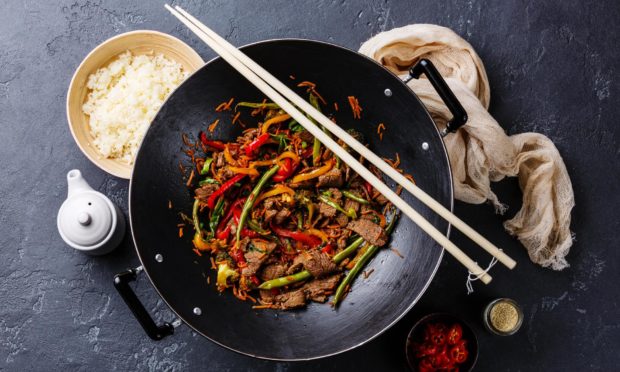As we move into the Chinese Year of the Tiger, today is the perfect time to spice up your stir fry.
And you can easily do just that with this beef and mushroom recipe which is quick to make and boasts heaps of flavour.
Stir-fries are incredibly simple, but there are a few tricks of the trade to ensure success every time:
- Use a wok rather than a frying pan. The shape gives you intense heat at the base and gradually less as you move up the sides. Go for carbon steel as non-stick coatings cannot conduct the high temperatures needed for stir frying.
- Get the oil in the wok smoking-hot before adding food. Use vegetable or sunflower oil for stir-frying, and sesame oil to flavour the food towards the end of cooking.
- Cut all the food into similar sized pieces for even and speedy cooking and blanch vegetables like leeks, mangetout and corn before stir-frying. It helps keep their colour and crispness.
- To achieve authentic egg-fried rice, cook the eggs first in the wok, then add the cooked, cold rice. That way you’ll get small pieces of egg separate from the grains of rice.
- Make sure you have a top-quality soy sauce which will not overpower the other ingredients.
If you would like other Year of the Tiger inspired recipes, click here.
Chilli beef and mushroom stir fry
Serves 4

Ingredients
- 350g beef steak, sliced into strips
- 3 tablespoons Kikkoman soy sauce
- Juice of 1 lime
- 1 tsp toasted sesame oil
- 1 red chilli, deseeded and very finely chopped
- 2 tablespoons sunflower oil
- 200g mushrooms, sliced or left whole if small
- 125g tenderstem broccoli
- 2 heads of baby pak choi, shredded
- 75g bean sprouts
Method
- In a dish, mix together the soy sauce, lime juice, sesame oil and chilli, add the steak and mix until they are well coated. Cover the dish with cling film and leave in the fridge to marinate for an hour.
- Heat 1 tablespoon of oil in a wok or large frying pan. Lift half the steak from the marinade and stir-fry over a high heat for two minutes until browned. Remove from the pan and set aside.
- Add the rest of the steak to the pan, reserving the marinade, and stir-fry for two minutes. Remove and set aside.
- Add the remaining oil to the pan and stir-fry the mushrooms for 2 minutes. Add the broccoli, stir-fry for 1 minute, then add the pak choi and bean sprouts and stir-fry for a further 1 minute.
- Return the steak to the pan, pour over the reserved marinade and toss everything together over the heat for two minutes until piping hot. Serve at once.
Recipe courtesy of Kikkoman soy sauce
